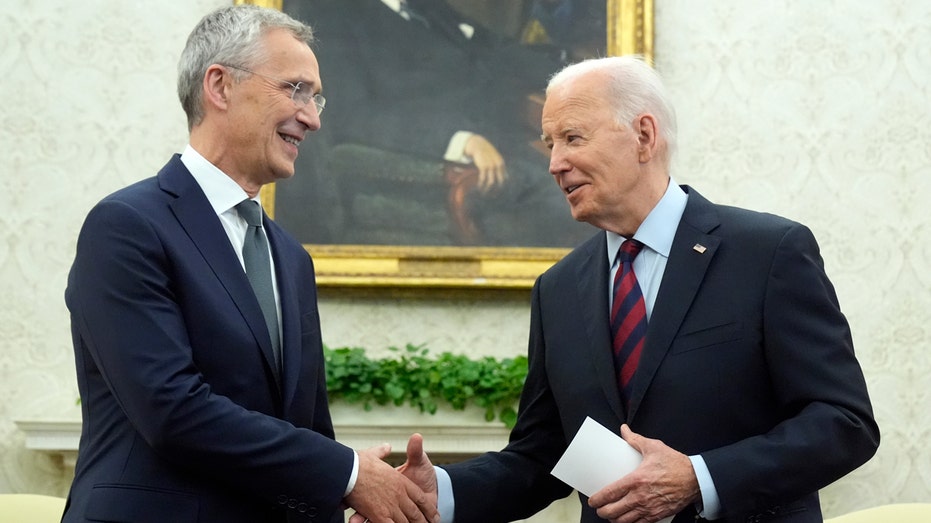
A record 23 of NATO’s 32 member nations are reaching the Western military alliance’s defense spending target this year, NATO Secretary-General Jens Stoltenberg said Monday. This comes as Russia’s war in Ukraine has increased the potential for wider conflict in Europe.
The estimated figure marks a significant increase from 2021, when only six nations were meeting the goal. This was prior to Russian President Vladimir Putin’s full-scale invasion in 2022.
“Europeans are doing more for their collective security than just a few years ago,” Stoltenberg said in a speech at the Wilson Center research group.
Following the speech, Stoltenberg met at the White House with President Joe Biden. The U.S. president stated that the alliance has become “larger, stronger and more united than it’s ever been” during Stoltenberg’s time as Secretary-General.
Biden spoke warmly of Stoltenberg, calling him “pal” and expressing his desire for Stoltenberg to serve another term when the current one ends in October.
“Together, we’ve deterred further Russian aggression in Europe,” Biden said. “We’ve strengthened NATO’s eastern flank, making it clear that we’ll defend every single inch of NATO territory.”
Stoltenberg noted that allies were purchasing more military equipment from the U.S. “So NATO is good for U.S. security, but NATO is also good for U.S. jobs,” he said.
In 2014, NATO members agreed to spend at least 2% of their gross domestic product on defense by 2024. The surge in spending reflects concerns about the war in Ukraine.
Poland, with a defense spending exceeding 4%, and Estonia, both bordering Russia, lead the United States this year in the percentage of their GDP allocated to defense.
Defense spending across European allies and Canada has risen nearly 18% this year alone, marking the largest increase in decades, according to NATO’s estimated figures released Monday.
Some countries are also concerned about the potential re-election of former President Donald Trump, who has previously criticized many NATO allies as relying excessively on U.S. military spending. He had also stated on the campaign trail that he would not defend NATO members that failed to meet defense spending targets.
“Shifting U.S. administrations have had the absolutely valid point to say that U.S. allies are spending too little,” Stoltenberg told reporters. “The good news is that’s changing.”
Stoltenberg’s visit is laying the groundwork for what is expected to be a pivotal summit of NATO leaders in Washington next month. The mutual-defense alliance has grown in strength and size since Russia’s invasion of Ukraine two years ago, with both Sweden and Finland joining.
Defense spending by many European countries declined following the collapse of the Soviet Union in 1991, as the perceived security threat to the West lessened.
But after Russia annexed Ukraine’s Crimean Peninsula in 2014, NATO members unanimously agreed to spend at least 2% of their GDP on defense within a decade. The full-scale invasion launched by Putin in 2022 prompted European countries on the front line of the conflict to prioritize meeting that target.
A significant focus of the summit is expected to be on what NATO and NATO member governments can do to support Ukraine in the face of ongoing air and ground attacks from Russia. They have so far resisted Ukrainian President Volodymyr Zelenskyy’s calls for his country’s inclusion in the bloc while the war continues.
Stoltenberg highlighted efforts to bolster Ukraine in the interim. This includes streamlining the eventual membership process for Ukraine and individual NATO nations providing updated arms and training to Ukraine’s military. This includes the U.S. providing F-16s and training Ukrainian pilots in the U.S. on the advanced aircraft.
“The idea is to move them so close to membership that when the time comes, when there is consensus, they can become a member straight away,” Stoltenberg said.
Stoltenberg asserted that only Ukraine’s inclusion in the alliance would deter Putin from attempting to conquer Ukraine again, regardless of how Russia’s offensive concludes.
“When the fighting ends, NATO membership” for Ukraine “assures that the war really ends,” he said.
The prospect of Ukraine joining NATO has long been a point of contention for Putin, and it was one of his stated justifications for annexing Crimea. Last week, he offered to order an immediate cease-fire if Ukraine renounced its plans to join the alliance, an offer dismissed by Ukraine.
A recent peace summit, intended as a first step toward peace, concluded with pledges to work towards a resolution but lacked concrete deliverables. The summit primarily involved Western nations, with Russia excluded. China did not participate, and India, Saudi Arabia, South Africa, and Mexico did not sign the meeting’s final document on Sunday.
Ukraine’s outnumbered and outgunned forces are battling to defend against the larger Russian army, which has seized significant territory after delays in the delivery of U.S. and European military aid due to political disputes. Ukraine has faced shortages of troops, ammunition, and air defenses in recent months as Russian forces attempt to cripple the national power supply and advance through the front line in eastern parts of the country.